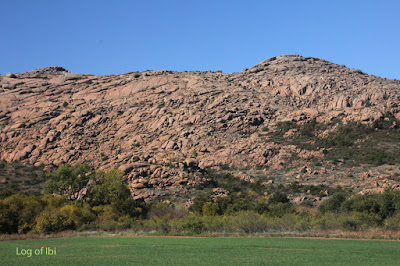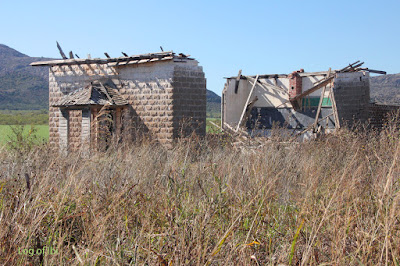The original Comanche settlement was along the stream believed
to flow through the line of wilderness between the field and the
mountains beyond.
We hoped to seek out the location
of the Comanche settlement on the North Fork of the Red River. The path we followed through the remains of
the village finally ended at a white, chained and locked gate. The sign on the gate proudly proclaimed
“Winters Farm, Est. 1889,” the year Pres. Benjamin Harrison chose to open 1.9
million acres of Indian Territory for white settlement. This first parcel was called “unassigned”
land. It was Indian Territory, but it
had not yet been assigned to a specific tribe.
The process of whittling away at Indian land would continue until nearly
all promised Indian land had been wrestled from Indian control.
It all comes back to America’s less
than proud history of ‘dealing’ with the Native Americans who called this land
their home. Greed, corruption, land
speculation, the undying thirst for getting something for nothing, and yes, the
starry-eyed dreams of poor settlers looking for a better life, caused all eyes
to turn toward the Indian lands. Land
encroachment always started with the cattlemen, as it continues to even today
with cattlemen grazing on public lands.
In “A Field of Their Own, 1830-1941,” John M. Rhea explains how the west
was really won. By 1880, Texas cattlemen
moved 4,233,487 Longhorn cattle onto Indian grasslands for a year at a
time. The following year those cattle
would be moved to more Indian land further north and closer to markets in
Kansas, and would be replaced by another herd.
This eventually led to the establishment of the Great Western Cattle
Trail, which was used to move the cattle straight through to the rail heads and
transportation to Northern and Eastern markets.
Some of the cattle were furtively or forcibly just driven onto the land,
and some land was acquired by grazing permits obtained through agreements with
the tribes. However, the methods by
which these permits were obtained were so irregular that word of these
practices traveled all the way to Washington.
“The degree of graft, exploitation, coercion, and violence perpetuated
by the range cattle operations, most of which were organized as companies by
this time, shocked Congress.” Think
about that! That Congress would be
shocked by anything should in itself tell us how pervasive and criminal these
practices were. “With no effective voice
to lobby in their defense, American Indians were at the mercy of Western
representatives who favored opening their lands.”
The cattlemen had other enemies
besides the tribes that rightfully owned the land, and those would be the
Boomers. The Boomers were an organized,
loud, forceful, persistent, and often militant group that advocated the
claiming of Indian lands by whatever means possible. They felt all land should be open to white
grazing and settlement, and they lobbied for Congress to make it so. Feeling that Indian lands were public lands
and available to anyone able to claim them, they overran the land a full decade
before official opening in 1889, forcing the U.S. Army to expel them on more
than one occasion. John Rhea said all this
wrangling and overrunning of their lands made the Indians ‘resentful.’ Imagine that!
The Indians and cattlemen shared
one thing in common. Neither wanted
settlers on the land. For the Indians,
settlers and cattlemen alike disrupted the movement of what buffalo remained,
and signaled the end of a life of plains hunting and dependence on
buffalo. The cattlemen didn’t want
settlers coming in and running barbed-wire fencing that disrupted cattle drives
or removed land from open use for grazing.
So the Indians had the land, and everyone else wanted it.
For an understanding of their claim
to their hunting lands, the Comanche were originally Shoshone, but broke away
from the main tribe in what became Southeast Wyoming and moved south some time
before 1700. When the U.S. Government
began taking an interest in the West, it promised 3,000,000 acres to the
Comanche, Apache, and Kiowa. By the time
all this fighting over the land was taking place, only 235,000 acres still
remained in native hands, meaning the Native Americans had already lost roughly
92% of their promised lands. And they
were resentful? Anyhow, I’m starting to
go far afield here, and was initially wanting to speak just of the history we
encounter while paddling. The crux of
this is there were a number of failed opportunities to put an end to the Indians’
fears of losing their lands, losing the opportunity to make a life for
themselves, and to prevent the subsequent hostilities. Sam Houston had the chance to put the
conflicts to bed as early as 1833 when all the Comanche were asking for was a
clear line delineating what was their land and what wasn’t. He failed to follow through, and was replaced
by Mirabeau B. Lamar, the second president of the Republic of Texas, who only
wanted to use war as a means of dealing with the “Indian problem.” The Comanche responded in the only way open
to them, and of course the government responded with war and the desire to
annihilate the Comanche and their way of life.
The history that followed is embarrassing, but very interesting to read
and study. I’ll leave that to you.
This was the site of the opening of the Christmas Day attack.
For the Comanche, Kiowa, Cheyenne, Arapaho,
and other tribes on the plains, it ended usually the same way. The winter campaign of 1868-69 planned to
attack the tribes in mid-winter when they would be at their weakest. The campaign led by Lt. Col. George A. Custer
first massacred Black Kettle’s Cheyenne village on 27 November 68. (Read about the Battle of Washita in achieves
for 29&30 June 2012.) A month later,
on Christmas Day, they opened fire on the Comanche village here with howitzer
field artillery before rushing in to destroy the village and kill its
inhabitants. Kiowa, encamped downstream,
heard the cannon fire and rushed in to provide support. They held the army at bay long enough for
women and children to escape. Initial
claims by the army were that 20-25 warriors were killed while fleeing, but more
detailed reports later proved that three soldiers were wounded, one fatally,
and one Comanche was killed, a sub-chief named Arrow Point. With the village now empty, the soldiers
destroyed it and then marched on.


















